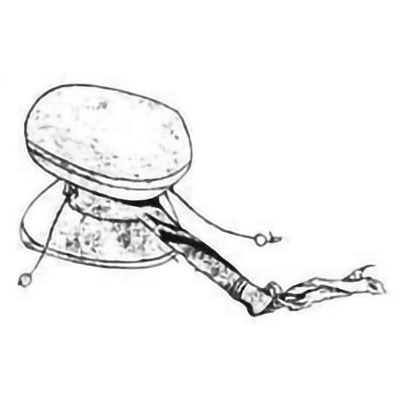damaru overview
 Damaru (Pinyin: Dá mǎ rú) is a Tibetan and Mongolian musical instrument that strikes the membrane. Tibetan is also known as Daru and Dari. In Mongolian, it is called Danbulenger and Bulenger. The Han people call it Dharma drum and rattle drum. It is popular in Tibetan Buddhist monasteries in Tibet and Inner Mongolia Autonomous Region.
Damaru (Pinyin: Dá mǎ rú) is a Tibetan and Mongolian musical instrument that strikes the membrane. Tibetan is also known as Daru and Dari. In Mongolian, it is called Danbulenger and Bulenger. The Han people call it Dharma drum and rattle drum. It is popular in Tibetan Buddhist monasteries in Tibet and Inner Mongolia Autonomous Region.With a long history, its shape is similar to the ancient shank drum. It is a small double-sided slender-waisted rattle without a wooden handle, but it is different from the rattle spread in the mainland. The drum body is composed of two bowl-shaped cavities that are butted at the bottom and communicated in the middle waist. In the old days, the skulls of two more people in the Tibetan area were made, and a hole was drilled in the center of the bottom, and glued to the wooden annular joint.
Some monasteries are also made of ivory, and the whole piece of ivory is selected to carve into shape. The Danbulenger in Tibetan Buddhist monasteries in Mongolian areas is mostly made of purple wood or mahogany. Drums vary in size and specifications. For the larger ones, the diameter of the drum surface is 20 cm to 30 cm, the thickness of the drum (two bowl-shaped drum shells) is 10 cm to 12 cm, and most of them are made of wood. The smaller ones, the diameter of the drum surface is 7 cm to 10 cm, the thickness of the drum is 7 cm to 8 cm, and most of them are made of human skull or ivory.
The drum surfaces of the small damaru are covered with dark green sheepskin (the film is immersed in patina and acid solution for coloring); the big damaru is covered with calf skin or pig skin. The drum body is mostly painted with brown, red or green paint. The drum waist (wooden joint) is tied with a leather rope or silk rope on the left and right sides. Colored ribbons or silk spikes are tied in the middle as decoration, and the ribbons are also decorated with small white shells, and some ribbons are as long as 50 cm.
In Tibetan areas, although both belong to Tibetan Buddhism, the dharmas used are different due to different sects. The ivory damaru of Lhasa (Gelugpai) has an oval drum surface, 9.5 cm long, 8.3 cm wide, 5.6 cm thick, 4.5 cm long and 4.5 cm long, and the drum surface is dark green.
When playing, the monk's right thumb and index finger hold the drum waist, and the rest of the fingers support the colored ribbons or drum ears, and quickly turn the wrist back and forth to make the drum pendant hit both ends of the drum surface to make a sound, and the sound is crisp and loud. It is an indispensable and representative religious musical instrument in Tibetan Buddhist monasteries. It is mainly used as a monastic instrument for chanting.
When monks chanting sutras together, the living Buddha or lama who leads the sutras hold and shake them, and when monks chanting sutras alone, they also need to strike Dharma. In addition, when Qiangmu or folk artists perform the Reba drum bell dance in the monastery, the lead dancer often holds a small damaru and dances while playing. The museum collects a side of damaru collected by the China Musical Instrument Museum, Institute of Music, China National Academy of Arts, Beijing. 9 cm, the silk rope is 7 cm long, and the pendant is two small red beads. This drum has been included in the large picture book "Chinese Musical Instruments Guide".
- Pinyin:Dá mǎ rú
- type:slamming membrane musical instrument
- popular area:Tibetan Buddhist monasteries in Tibet and Inner Mongolia Autonomous Region
- Tibetan nickname:Daru, Darri
- Chinese nickname:Drum, rattle
- Mongolian nickname:Danbulenger, Bulenger
overview of other similar instruments
- sanyanxiao overview
- Daguangxian overview
- Leiqin overview
- hahao overview
- yandundagu overview
- Han Xiaozheng overview
- Fang Xiang overview
- guanzi overview
- zhuqin (Dao Qin) overview
- zhuiqin overview
- bangzi overview
- three-stringed piano overview
- Gehu overview
- xiao overview
- xiaokonghou overview
- Konghou overview
- Sheng overview
- suona overview
- hulusi overview
- gushao overview
 渝公网安备 50010702504639号
渝公网安备 50010702504639号